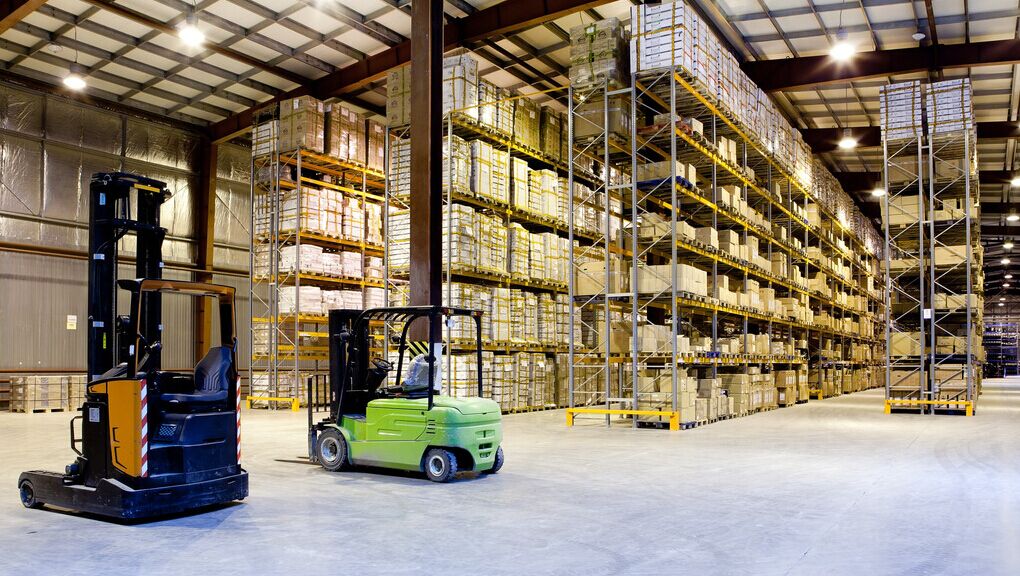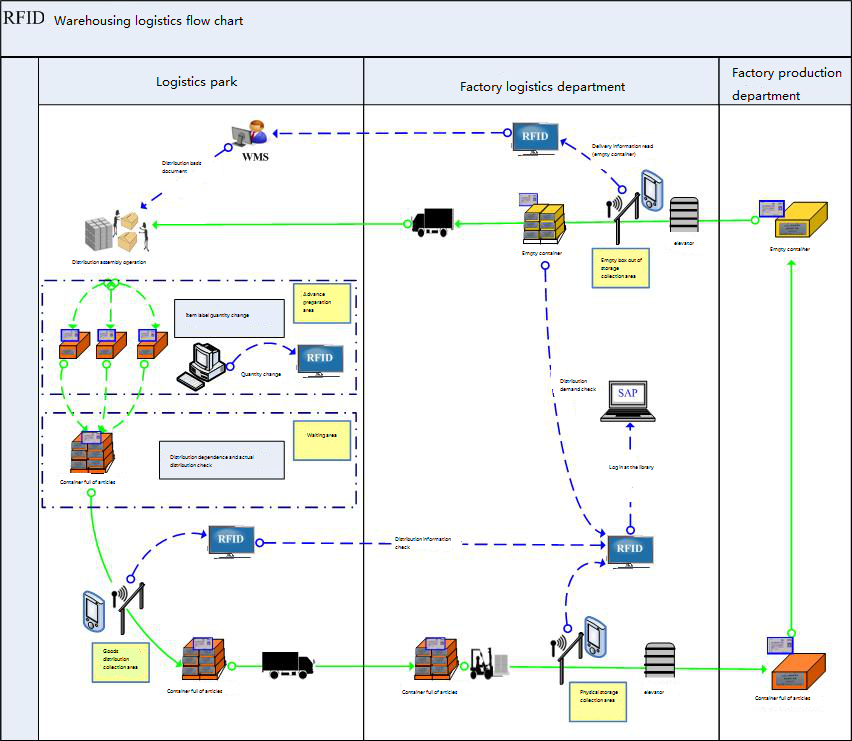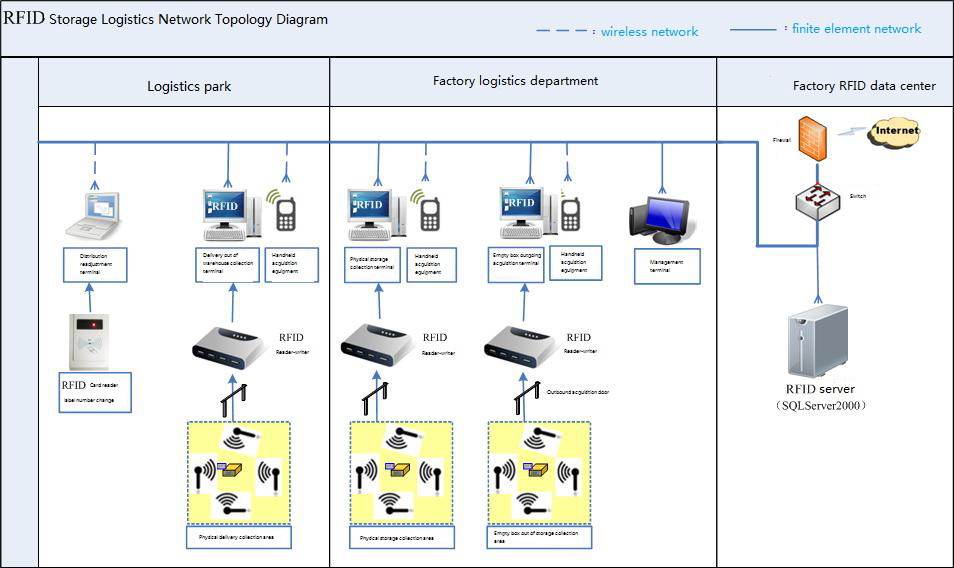Intelligent Warehouse Logistics Management
1.System Introduction
With the development of economic globalization and the rise of the Internet, the global logistics service industry accelerates development. With the development of global economic integration, the collaborative relationships among enterprises such as purchasing, warehousing, sales and distribution are becoming more and more complicated. The competition among enterprises is not only the competition of product performance and quality, but also the competition of logistics ability. Use information technology instead of actual operation, reduce waste, save time and cost, realize seamless docking and integration of supply chain in order to realize information management of logistics process, adopt information management means to warehouse the company. Integrated management of logistics information to promote data sharing, turnover of goods and funds, and efficiency, RFID Warehouse Logistics Management system is a platform based on RFID identification technology for goods identification tracking, management and inspection of goods information, in which tracking mainly includes distribution requirements. The system combines the advanced RFID identification technology with the database management query of the computer, automatically recognizes the goods information, realizes the automation and information of the enterprise logistics operation, and so on function modules, such as delivery of goods, storage of goods and delivery timeout, the system combines the advanced RFID identification technology with the database management query of the computer. At the same time, the RFID technology and the enterprise information system can be connected seamlessly to ensure the maximum benefit of the RFID technology in the enterprise logistics operation.


3.System Functions
The RFID warehouse logistics management system carries on the intelligence, the information management to the enterprise logistics goods, realizes sends the distribution demand information automatically, tracks the goods delivery situation in real time, automatically records the goods enters the storehouse information, System automatic alarm and WMS system real-time docking and other functions. The system flow chart is shown below.

With the development of economic globalization and the rise of the Internet, the global logistics service industry accelerates development. With the development of global economic integration, the collaborative relationships among enterprises such as purchasing, warehousing, sales and distribution are becoming more and more complicated. The competition among enterprises is not only the competition of product performance and quality, but also the competition of logistics ability. Use information technology instead of actual operation, reduce waste, save time and cost, realize seamless docking and integration of supply chain in order to realize information management of logistics process, adopt information management means to warehouse the company. Integrated management of logistics information to promote data sharing, turnover of goods and funds, and efficiency, RFID Warehouse Logistics Management system is a platform based on RFID identification technology for goods identification tracking, management and inspection of goods information, in which tracking mainly includes distribution requirements. The system combines the advanced RFID identification technology with the database management query of the computer, automatically recognizes the goods information, realizes the automation and information of the enterprise logistics operation, and so on function modules, such as delivery of goods, storage of goods and delivery timeout, the system combines the advanced RFID identification technology with the database management query of the computer. At the same time, the RFID technology and the enterprise information system can be connected seamlessly to ensure the maximum benefit of the RFID technology in the enterprise logistics operation.

2.System Topology
This system integrates RFID technology, Webservice communication technology, computer control technology, network technology in one high-tech products. The network topology diagram of the system is shown in the following figure.
This system integrates RFID technology, Webservice communication technology, computer control technology, network technology in one high-tech products. The network topology diagram of the system is shown in the following figure.

3.System Functions
The RFID warehouse logistics management system carries on the intelligence, the information management to the enterprise logistics goods, realizes sends the distribution demand information automatically, tracks the goods delivery situation in real time, automatically records the goods enters the storehouse information, System automatic alarm and WMS system real-time docking and other functions. The system flow chart is shown below.

♦Automatic transmission requirements: The production line automatically collects empty containers and automatically sends and distributes the distribution requirements through acquisition and scanning;
♦ Distribution of physical objects: logistics companies deliver goods on time and according to delivery requirements;
♦ Factory physical storage: automatic identification of goods into the warehouse, automatic matching of distribution requirements, improve the efficiency of goods storage;
♦ Distribution abnormal alarm: During the delivery process, when the system detects the delivery timeout and the delivery abnormality, the system automatically alarms the alarm;
♦ Principle of acquisition technology: After the goods container enters the collection area, the collection equipment automatically identifies multiple items by collecting RFID tags, thereby efficiently completing the goods entering and leaving the warehouse, ensuring whether the physical and distribution requirements are consistent, and improving the efficiency of goods distribution;
♦ Benefits of implementation: When the goods enter and leave the warehouse, the equipment can automatically and quickly identify the goods, and at the same time automatically match the distribution requirements, improve the efficiency of goods entering and leaving the warehouse;
♦ Real-time: master the distribution of all goods in real time, accurately grasp the inventory situation, optimize the reasonable inventory, and grasp the status and changes of the warehouse environment in real time;
♦ Scalability: It realizes centralized management, distributed operation and real-time monitoring functions across regions, efficiently completes various business operations, improves warehouse management, and improves efficiency and value.
4.Applicable Area
With the maturity of RFID technology, its application is becoming more and more extensive. The combination of RFID front-end equipment (label, card reader) and enterprise core system can be widely used in the field of supply chain and warehouse logistics management. Effectively solve the problems of input / output of business operation data, control and tracking of business process, and reduce the error rate in the supply chain.
♦ Retail link
RFID can improve the inventory management of retailers, realize timely replenishment, track transportation and inventory effectively, improve efficiency and reduce errors. At the same time, the intelligent label can monitor the validity of some time-efficient goods, and the store can use RFID system to realize automatic scanning and billing at the payment desk, so as to replace manual collection. RFID tags in the supply chain terminal sales links, especially in the supermarket, free of human intervention in the tracking process, and can generate 100% of the accurate business data, so it has a great appeal.
♦ Storage link
In warehouse, RF technology is widely used to access goods and inventory, which can be used to automate inventory and goods collection. In the whole warehouse management, the receiving plan, delivery plan and shipment plan made by the supply chain planning system can be combined with RFID technology to efficiently accomplish various business operations, such as designated stacking area, etc. Take goods on the shelf and make up the goods, etc. In this way, the accuracy and rapidity of the operation is enhanced, the quality of service is improved, the cost is reduced, the labor force and inventory space is saved, and the entire logistics is reduced because of goods misplaced, misdelivered, stolen, damaged and stocked. Loss caused by shipping errors, etc. Another benefit of RFID technology is that it reduces manpower during inventory counts. The RFID is designed to automate the registration of goods, without the need for manual checking or scanning bar codes, so that they are faster and more accurate. The RFID solution can provide accurate information about the stock situation, which allows managers to quickly identify and correct inefficient operations, thus achieving rapid delivery and minimizing storage costs.
♦Transport links
4.Applicable Area
With the maturity of RFID technology, its application is becoming more and more extensive. The combination of RFID front-end equipment (label, card reader) and enterprise core system can be widely used in the field of supply chain and warehouse logistics management. Effectively solve the problems of input / output of business operation data, control and tracking of business process, and reduce the error rate in the supply chain.
♦ Retail link
RFID can improve the inventory management of retailers, realize timely replenishment, track transportation and inventory effectively, improve efficiency and reduce errors. At the same time, the intelligent label can monitor the validity of some time-efficient goods, and the store can use RFID system to realize automatic scanning and billing at the payment desk, so as to replace manual collection. RFID tags in the supply chain terminal sales links, especially in the supermarket, free of human intervention in the tracking process, and can generate 100% of the accurate business data, so it has a great appeal.
♦ Storage link
In warehouse, RF technology is widely used to access goods and inventory, which can be used to automate inventory and goods collection. In the whole warehouse management, the receiving plan, delivery plan and shipment plan made by the supply chain planning system can be combined with RFID technology to efficiently accomplish various business operations, such as designated stacking area, etc. Take goods on the shelf and make up the goods, etc. In this way, the accuracy and rapidity of the operation is enhanced, the quality of service is improved, the cost is reduced, the labor force and inventory space is saved, and the entire logistics is reduced because of goods misplaced, misdelivered, stolen, damaged and stocked. Loss caused by shipping errors, etc. Another benefit of RFID technology is that it reduces manpower during inventory counts. The RFID is designed to automate the registration of goods, without the need for manual checking or scanning bar codes, so that they are faster and more accurate. The RFID solution can provide accurate information about the stock situation, which allows managers to quickly identify and correct inefficient operations, thus achieving rapid delivery and minimizing storage costs.
♦Transport links
In transportation management, the goods and vehicles transported on the way are labeled with RFID tags, and the RFID receiving and forwarding devices are installed at some checkpoints of the transportation line. After receiving the RFID tag information, the receiving device uploads it to the communication satellite along with the location information of the receiving place, and then transmits it to the transportation dispatching center and sends it to the database.
♦Distribution/Distribution Link
♦Distribution/Distribution Link
In the distribution sector, the use of radio frequency identification technology can greatly accelerate the speed of distribution, improve the efficiency and accuracy of the picking and distribution process, and reduce labor and distribution costs. If all goods arriving at the central distribution center are tagged with RFID, when entering the central distribution center, the tray reads the contents of the tags on all containers on the tray through a reader. The system checks these information with the shipping record to detect possible errors, and then updates the RFID tag to the latest storage location and status. This ensures accurate inventory control, and even gives a precise idea of how many containers are in transit, where and where they originate, and when they are expected to arrive.
♦Production link
The application of RFID technology in production and manufacturing can complete the operation of automated production line, realize the identification and tracking of raw materials, components, semi-finished products and finished products in the whole production line, reduce the cost of manual identification and error rate, and improve efficiency and efficiency. Especially in the production line using JIT (Just-in-Time) just-in-time mode, raw materials and components must be delivered to the work station on time. After using RFID technology, we can quickly and accurately identify the raw materials and components needed by the workstation from a wide variety of inventory by identifying electronic tags. RFID technology can also help managers send replenishment information in time according to production schedule, realize balanced and steady production line, and strengthen the quality control and tracking.
上一篇:没有了
下一篇:Urban Intelligent Transportation
下一篇:Urban Intelligent Transportation
